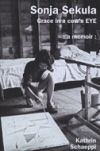Sonja Sekula
Sonja Sekula (1918-1963) was a Swiss “poète-peintre” (poet-painter) who lived for a time in New York, was a colleague and friend of better known artists of her time (Jackson Pollock, Frida Kahlo, John Cage, Leonora Carrington, Max Ernst), experimented with “blended poetic word combinations” in her visual work, and spent much time “in and out of clinics” because, Schaeppi explains in her book’s epilogue, “her many secret art books and diaries tell of her passion for women in a time when same-sex love was considered a pathology to be cured with extreme treatments.”
Sonja Sekula (1918-1963) was a Swiss “poète-peintre” (poet-painter) who lived for a time in New York, was a colleague and friend of better known artists of her time (Jackson Pollock, Frida Kahlo, John Cage, Leonora Carrington, Max Ernst), experimented with “blended poetic word combinations” in her visual work, and spent much time “in and out of clinics” because, Schaeppi explains in her book’s epilogue, “her many secret art books and diaries tell of her passion for women in a time when same-sex love was considered a pathology to be cured with extreme treatments.”
Schappei’s “poetic memoir” is an homage to Sekula’s work. Every poem in the book is based on Sekula’s paintings and writings. The appendix includes a detailed list and descriptions along the lines of a museum or gallery catalogue of every work of Sekula’s on which these texts are based. Schaeppi, who lives in Switzerland, studied creative writing in the US and writes in English, says her memoir represents “but a trace.” My review must be, too, only a “trace,” as it is difficult to provide a true picture (pun intended) of the book, given its fundamental visual components. Like Sekula, Schaeppi blends visual and verbal images and texts, including text in a wide variety of spatial arrangements across the page, graphic elements that include columns, boxes, grids, a variety of font types, sizes, and treatments, symbols, swashes of ink in various shades, and other painterly and graphic elements.
Verbal texts range from stream of consciousness outpourings of phrases linked by vague, dreamy, imagined connections; short lyrical bursts; poems created of lists, charts, grids, and graphs; prose poems; and a variety of other postmodern configurations and permutations of language and forms. There are references to Sekula’s struggle with “cures” for her lesbianism; to her friends in the art world; to the life of an artist; to the meaning of artistic imagery; and to specific performances and artistic works. There are references to the history and social circumstances of Sekula’s life (WWII, poverty, the post-war rebuilding of cities) and to the intellectual preoccupations of her era (developments in the sciences, for example).
Schaeppi imagines and channels Sekula’s voice, her yearnings, her pain and personal and emotional challenges, her perspective, her unique intelligence with compassion and passion. Here are the concluding lines of “Give me, 1948”:
a totempole of me·envious me·impatient me-·depressed me
·frustrated desiring competitive me·sweet little girl me·
ungiving me·longing unloved me·caged me·ghost of me
This is an utterly fascinating book that succeeds in bringing to light the work of an artist whose work would likely be otherwise unknown to many of us. Thanks to Schaeppi, Sekula is no longer a ghost, overshadowed entirely by the better-known artists of her time. She is now a figment of Schaeppi’s imagination—and of my own. I can’t wait to see what Schaeppi will imagine next.





